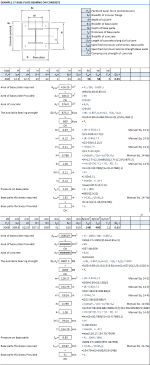AISC Base plate for compression

Description
The design of a base plate according to the American Institute of Steel Construction (AISC) involves several steps. Here's a general outline of the process using the input values you provided:
-
Area of Base Plate Required: This is determined by dividing the factored axial force (Pu) by the allowable bearing stress of the concrete (0.65*sqrt(f'c) for normal weight concrete).
Area_required = Pu / (0.65*sqrt(f'c)) -
Area of Base Plate Provided: This is simply the breadth of the base plate (B) times the depth of the base plate (N).
Area_provided = B * N -
Area of Concrete: This is the breadth of the concrete (Bc) times the length of the concrete along the depth of the column (DC).
Area_concrete = Bc * DC -
The Available Bearing Strength: This is the area of the concrete times the allowable bearing stress of the concrete.
Bearing_strength = Area_concrete * (0.65*sqrt(f'c)) -
Pressure on Base Plate: This is the factored axial force (Pu) divided by the area of the base plate provided.
Pressure = Pu / Area_provided -
Base Plate Thickness Required: This is determined by a more complex calculation that considers the bending in the base plate due to the eccentricity of the load, the material properties of the base plate (fyp and fup), and the geometry of the base plate and column. This typically involves checking two cases: one for a moment about the weak axis of the column and one for a moment about the strong axis of the column. The larger thickness from these two checks is used.
-
Base Plate Thickness Provided (tp): This is an input value and should be checked to ensure it is greater than the base plate thickness required from the above calculation.
Please note that this is a simplified overview of the process and the actual design should be performed according to the detailed provisions and checks in the AISC specification. The design should also consider other factors such as the location of anchor bolts, the type of welds or bolts used to connect the column to the base plate, and the possibility of additional loads such as moments or shear forces.
Calculation Reference
Welding
Weld Strength LRFD
AISC
Calculation Preview
Full download access to any calculation is available to users with a paid or awarded subscription (XLC Pro).
Subscriptions are free to contributors to the site, alternatively they can be purchased.
Click here for information on subscriptions.


